
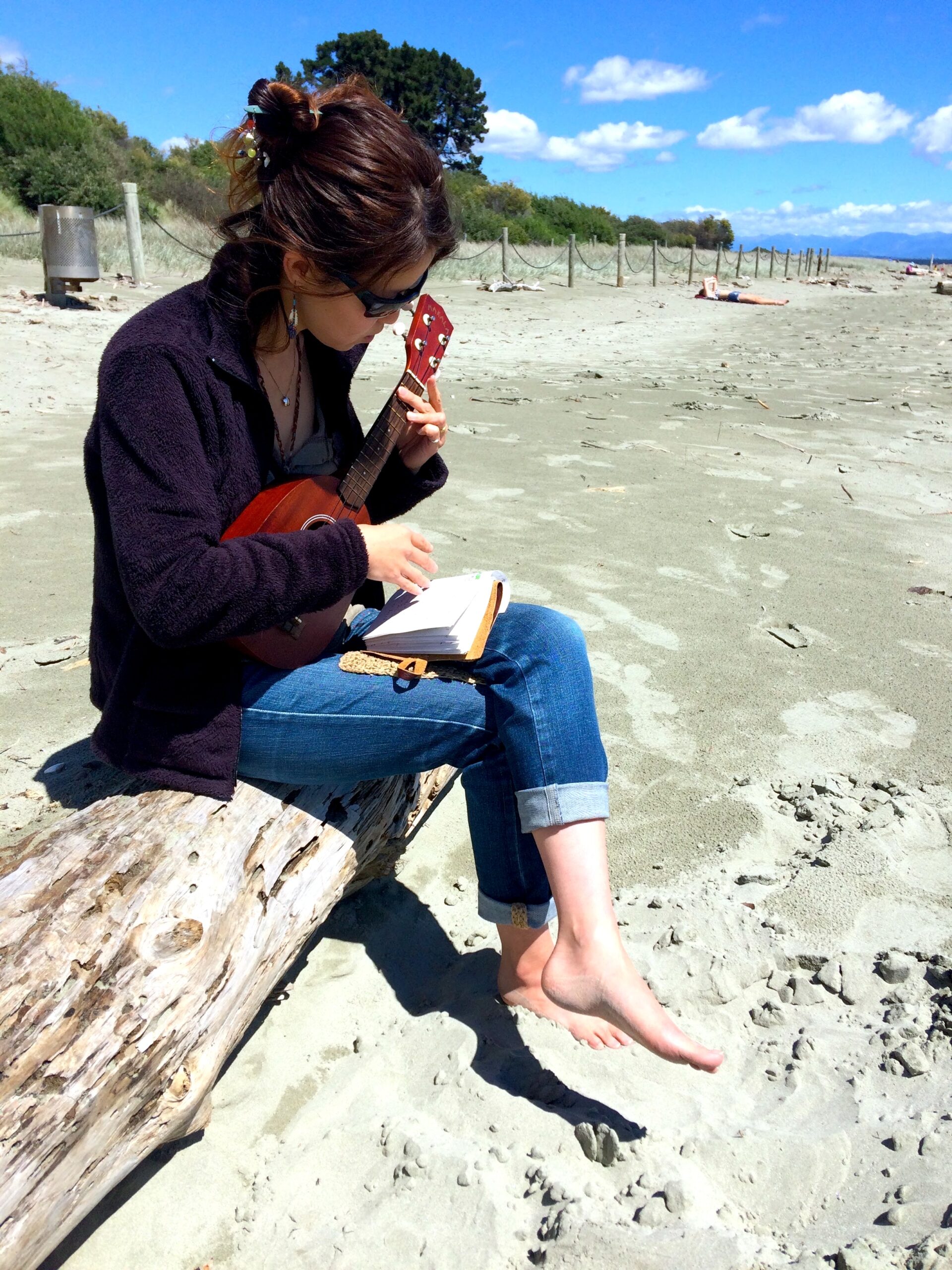
Karate is more than just a martial art—it is a lifelong path of discipline, respect, and self-improvement. From its humble Okinawan origins to its recognition on the world stage, karate has grown into a global phenomenon admired for its balance of tradition and adaptability, practiced in countless karate schools across the world.
In this guide, you’ll explore leading styles such as Shotokan, Kyokushin, and Enshin, uncover the practice of kata and kumite, and find resources that make learning possible anywhere, including unique cultural programs by MOTENAS JAPAN. Whether you’re stepping into your first dojo or pursuing mastery, karate offers lessons and inspiration that last a lifetime.
What Is Karate? Origins and Evolution
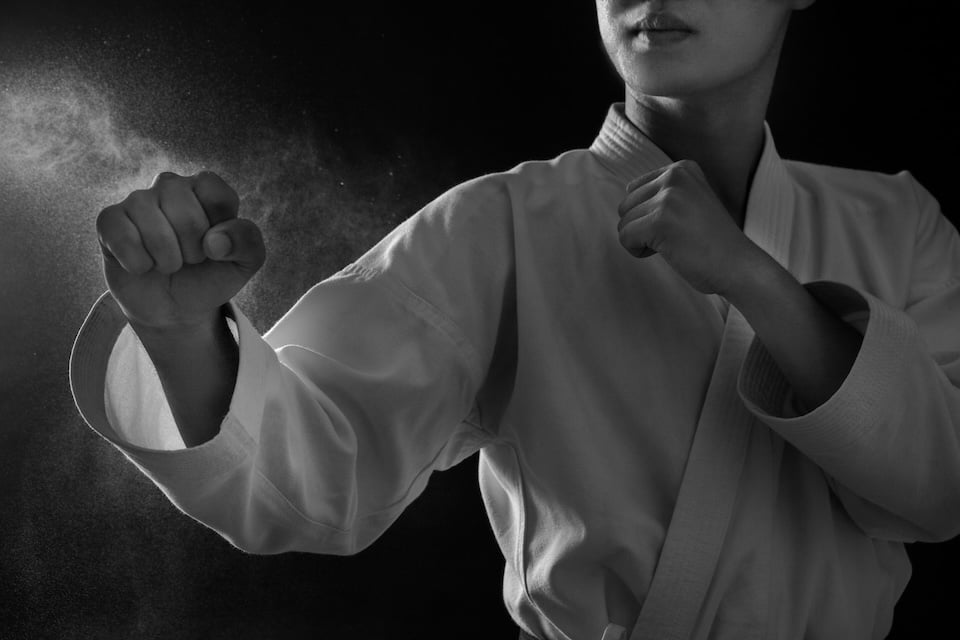
From Okinawa’s secret roots and Chinese influence to its rise in Japan and the modern world, karate evolved from simple self-defense into a global martial art that inspires millions. This journey reflects its essence: tradition, discipline, and worldwide connection across cultures.
The roots of karate in Okinawa and China
Karate originated in Japan but traces its roots to the Ryukyu Kingdom (Okinawa) with strong influences from China. As early as the 14th century, Okinawans practiced Te (手, Tī, “hand”), a form of unarmed self-defense.
When Chinese traders and martial artists brought their techniques to Okinawa, these methods fused with Te to form Tōdi (“Tang Hand”), a precursor of modern karate. Because weapons were often banned, the art was taught in secrecy, preserved within noble families. By the 18th and 19th centuries, towns like Shuri, Naha, and Tomari had developed distinct styles, combining Chinese martial principles with Okinawan techniques — laying the foundation for today’s empty-hand martial art.
From “Tang Hand” to modern martial art in Japan
During the late 19th century Meiji period, Okinawa integrated into Japan, and karate – then called Tang Hand (唐手, Tōdī) – began spreading to the mainland. Ankō Itosu played a key role, introducing karate into Okinawan schools in 1901, moving it from secret practice to public education.
In 1922, Gichin Funakoshi demonstrated karate in Tokyo, sparking national interest. By the 1930s, the name changed from 唐手 (“Tang Hand”) to 空手 (Karate, “empty hand”), reflecting its identity as a Japanese martial art. Funakoshi also adopted the karategi (空手着, karategi) and colored belt system from judo, modernizing karate training into the form we recognize today. By World War II, karate had established dojos (道場, dōjō) across Japan, evolving into karate-dō – “the way of the empty hand.”
Global spread of karate after World War II
After World War II, karate spread rapidly worldwide. American servicemen stationed in Okinawa and Japan trained in local dojos and later opened schools in the U.S. during the 1950s–60s. At the same time, Japanese masters traveled abroad to teach in Hawaii, Europe, and South America, fueling karate’s transformation into a truly international art.
Karate’s growth led to formal competitions: the first All-Japan Karate Championship (1957), followed by the All-Japan tournament (1969), and the founding of the World Karate Federation (1970), which unified global rules. Pop culture, from Bruce Lee films to The Karate Kid in the 1980s, boosted its popularity further. Today, karate is practiced by 100 million people in over 150 countries, earning the title “The World’s Karate.”
Major Karate Styles and Schools
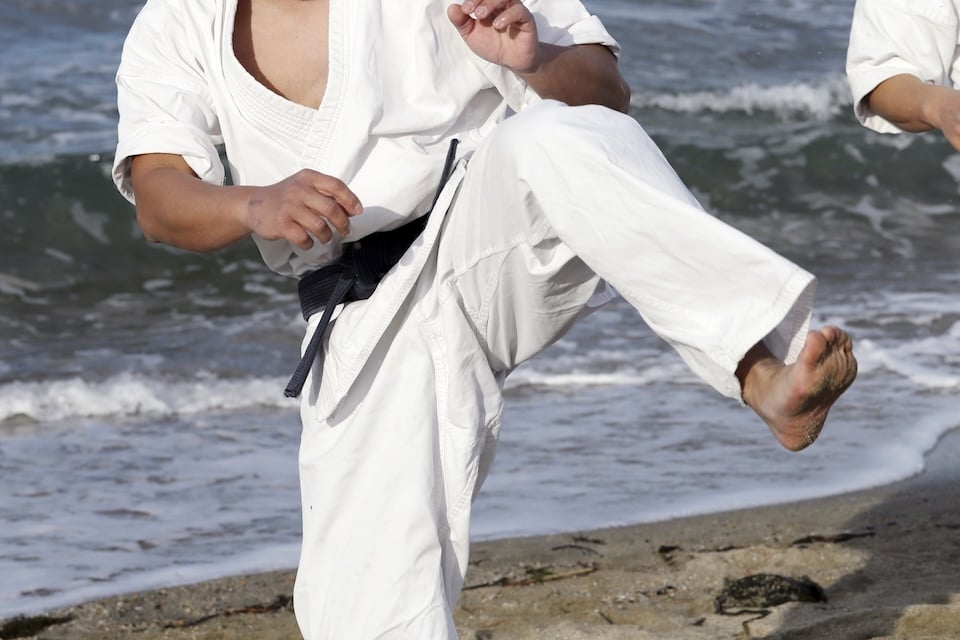
Karate is a martial art of many styles, each shaped by history and philosophy. From disciplined forms to full-contact combat, these variations show how karate adapts to different needs and cultures.
The most recognized include Shotokan, Kyokushin, Enshin, and other traditional schools like Gōjū-ryū and Shitō-ryū. Together, they highlight karate’s balance of tradition and innovation, offering every student a path to grow and discover their own journey in martial arts.
Shotokan: The Most Practiced Style Worldwide
Shotokan is the world’s most widely practiced karate style, known for its deep stances and powerful linear techniques. Founded by Gichin Funakoshi, the pioneer who brought karate to mainland Japan, it emphasizes kihon (basics) and a wide range of kata. The style’s disciplined training, low stances for strength, and its core philosophy of “there is no first strike in karate” define its unique character.
Its global spread came through the Japan Karate Association (JKA), which sent instructors abroad in the 1960s. Today, countless dojos worldwide follow Shotokan methods, making it the foundation for millions of karate students seeking precision, power, and tradition.
Kyokushin: Full-Contact Power and Spirit
Kyokushin (極真, Kyokushin, “Ultimate Truth”), founded by Masutatsu Oyama in 1964, is known for its full-contact fighting and extreme physical conditioning. Unlike Shotokan’s controlled sparring, Kyokushin emphasizes bare-knuckle kumite, powerful kicks, and body punches, often aiming for knockdowns. Training includes knuckle push-ups, board breaking, and rigorous drills, building both toughness and resilience.
Beyond physical strength, Kyokushin teaches unbreakable spirit (精神, seishin). Students embrace the motto “osu,” symbolizing patience and perseverance. Oyama’s legendary feats—like fighting bulls and mountain training—shaped this ethos. Today, Kyokushin has a global following that attracts those seeking a hardcore martial challenge rooted in discipline and spirit.
Enshin: Sabaki Method and Circular Defense
Enshin Karate, founded by Joko Ninomiya in the 1980s, evolved from Kyokushin and is defined by the sabaki method—a strategy of circular movement, redirection, and off-balancing. Instead of clashing head-on, practitioners step offline, redirect attacks, and counter from safer angles, creating a fluid and strategic style.
While still full-contact, Enshin emphasizes timing and positioning over brute strength. Its annual Sabaki Challenge, a world-renowned tournament, showcases throws and strikes under unique rules, attracting fighters worldwide. Though smaller than Shotokan or Kyokushin, Enshin is respected internationally for its practical self-defense approach blending karate with judo-like sweeps and aikido-like redirection.
Other Traditional and Modern Karate Schools
Beyond Shotokan, karate includes many traditional and modern styles, each shaped by unique philosophies. Among the four main styles in Japan: Gōjū-ryū blends hard strikes with circular movement and breathing control, Shitō-ryū is renowned for its vast kata repertoire, and Wadō-ryū integrates jujutsu principles with lighter, evasive footwork.
Okinawa also preserves roots like Shōrin-ryū and Uechi-ryū, while newer systems such as Shūkōkai, Kūdō, and American hybrids reflect karate’s evolution. Despite differences, all schools share core techniques, discipline, and respect. International tournaments under the World Karate Federation unite practitioners from diverse ryūha, proving that karate is not a single art but a family of traditions. For beginners, exploring styles is a way to find the balance—whether in philosophy, sport, or self-defense—that resonates most.
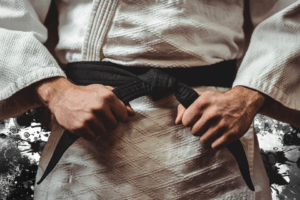
Karate Classes and Dojos: How to Start Training
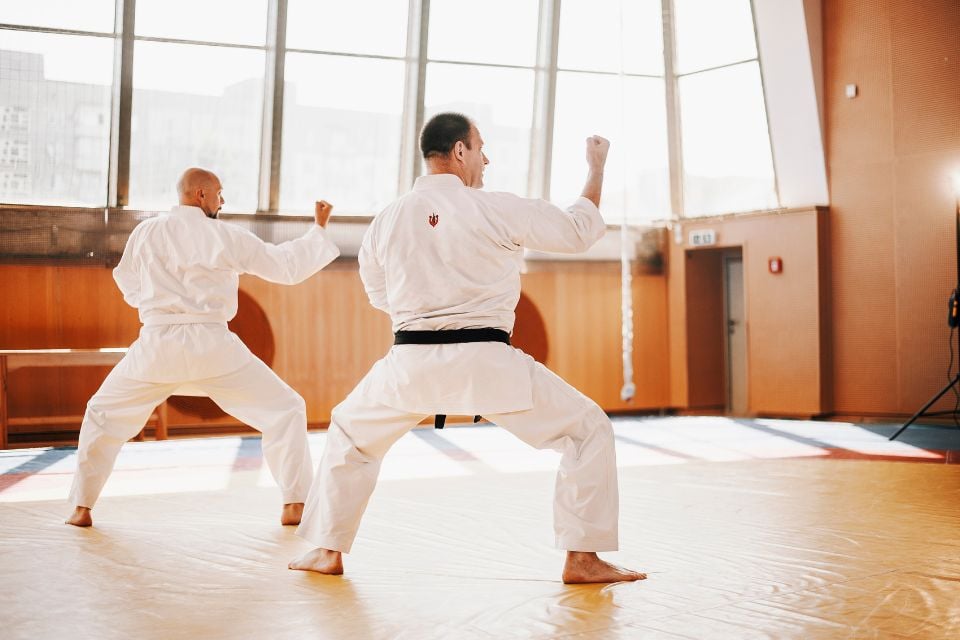
Starting karate is exciting, but knowing what to expect helps. From your first class to finding the right dojo, you can begin with confidence.
With options for kids and adults, plus affordable costs and flexible schedules, karate is accessible and rewarding for beginners at any age.
What to Expect in Your First Karate Class
Your first karate class may feel exciting yet a bit intimidating, but the structure is designed to ease beginners in. Classes usually start with a respectful bow (礼, rei), followed by warm-ups and kihon (basic techniques) like stances, punches, blocks, and kicks. You might also practice a simple kata or partner drills, often counting in Japanese (ichi, ni, san…).
Don’t worry about sparring right away—most first-timers won’t. Instead, expect clear guidance, corrections on form, and a supportive atmosphere where senior students help beginners. Training is done barefoot, and if you don’t have a karategi (空手着, karategi) yet, regular gym clothes work fine. By the end, you’ll get a taste of karate’s discipline, etiquette, and energy, marking the start of a rewarding journey.
How to Find the Right Karate School Near You
Choosing the right dojo (道場, dōjō) is key to enjoying karate long-term. Consider what style or focus appeals to you: full-contact options like Kyokushin for realism, or traditional schools like Shotokan for kata and competition. More important than style, however, is instructor quality—look for certified teachers with patience and experience.
Most dojos offer trial classes, so observe: is the training safe, structured, and engaging? Other factors include facilities, schedule, and culture. A clean, safe space with times that fit your lifestyle makes training sustainable. Pay attention to the atmosphere—some dojos are highly traditional, others more relaxed. Ultimately, the right dojo is where you feel comfortable, challenged, and motivated, supported by an instructor who genuinely cares about their students’ progress.
Where to Experience Karate in Tokyo
If you’re traveling in Japan and want a short-term karate experience, Tokyo offers world-class dojos that welcome international guests:
- JKA Headquarters Dojo (Bunkyo) – The official home of Shotokan karate. Visitors can train where the Japan Karate Association was founded, experiencing traditional techniques directly at the source.
- Kyokushin Honbu Dojo (Ikebukuro) – The spiritual center of Kyokushin, founded by Mas Oyama. Known for full-contact training, it attracts practitioners from all over the world.
- Tokyo Sumida Dojo (Sumida-ku / Ueno-Okachimachi) – A friendly dojo led by world-class instructors, offering programs suitable for beginners, families, and tourists looking for an authentic experience.
Kids vs. Adult Classes: Different Goals and Benefits
Many dojos tailor classes for kids (ages 5–12) and adults (teens and older). While the techniques are the same, the approach differs. Kids’ classes emphasize fun, structure, and confidence-building through games, drills, and belt promotions, helping develop focus and discipline.
Adult classes provide rigorous workouts, stress relief, and self-defense training with deeper exploration of kata and philosophy. Benefits vary: kids gain better behavior and concentration, while adults improve fitness, flexibility, and empowerment. Some dojos even offer family classes, making karate accessible and rewarding for all ages.
Average Costs and Training Schedules
| Item | Average Cost | Notes |
| Monthly Tuition | $50–$150 | Varies by location and dojo reputation |
| Registration Fee | ~$50 | One-time cost at enrollment |
| Karategi (空手着, karategi) | $30–$100 | Uniform; beginners often start with lightweight |
| Belt Testing | $20–$50 | Charged at each promotion test |
| Annual Membership | $50–$100 | Required by some dojos or federations |
Training schedules typically include 2–3 classes per week. Kids’ sessions last about 1 hour, while adult classes run 1–1.5 hours. Beginners often train twice weekly, reaching black belt in 3–5 years with consistent effort.
Extras may include seminars, training camps, or family programs. While costs are moderate, the fitness, skills, and community benefits make karate a rewarding investment.
Karate Techniques and Practice
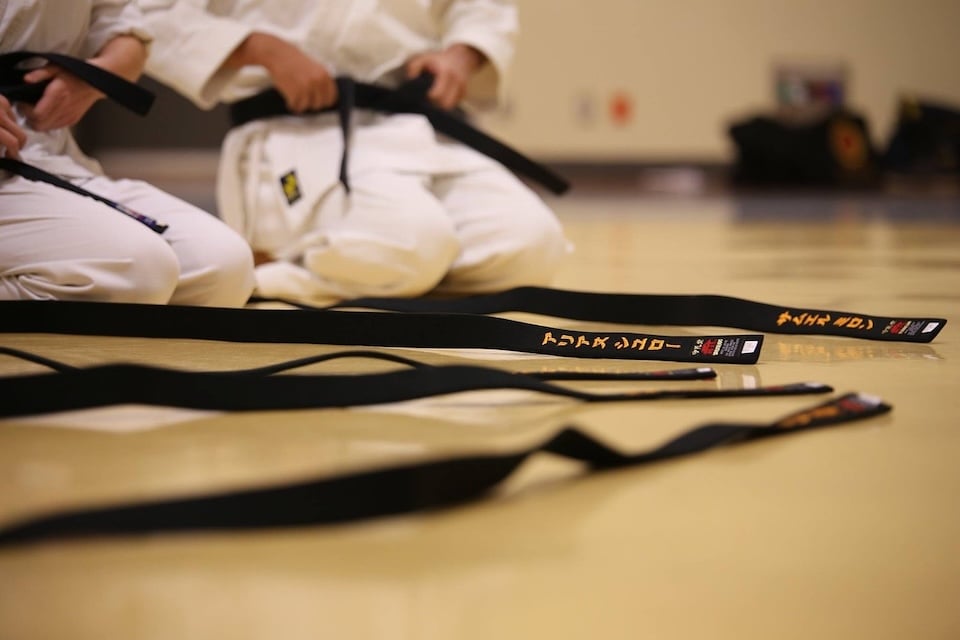
Karate’s essence is found in its training methods and core techniques. From kata that preserve tradition, to kumite that tests real-time application, to the belt system that marks progress, every step in practice builds discipline and confidence.
Learning essential stances, strikes, and kicks not only develops physical skill, but also instills focus, respect, and perseverance that extend far beyond the dojo.
Kata: Forms that Preserve Tradition
Kata (型, kata) are pre-arranged sequences of punches, kicks, and blocks that preserve centuries of karate wisdom. Each form represents a combat scenario against imaginary opponents, teaching balance, rhythm, and precise technique. Beginners often start with Heian Shodan (平安初段), a simple sequence that builds strong fundamentals.
Beyond technique, kata embody tradition and philosophy. Names often carry symbolic meaning, and advanced interpretations (bunkai) reveal hidden self-defense applications. Practiced in every class and judged in tournaments, kata serve as a living textbook of karate, connecting modern students to the art’s historical roots.
Kumite: Sparring and Real-time Application
Kumite (組手, kumite) means “meeting of hands” and refers to sparring, where karate techniques are applied in real time. It ranges from structured drills (one-step sparring) to jiyū kumite (free sparring) and even point-based matches under Shotokan or Olympic rules. In contrast, Kyokushin’s full-contact kumite emphasizes knockdowns, testing endurance and spirit.
Protective gear helps beginners, while advanced training develops timing, distance (間合い, maai), and adaptability against different opponents. More than fighting, kumite builds confidence, resilience, and the ability to apply karate under pressure.
Belt System and Progression to Black Belt
Karate’s colored belt system symbolizes progress, adapted from judo in the early 20th century. Students advance from white (innocence) through yellow, green, blue, and brown, toward the black belt (黒帯, kuro-obi), which marks a serious beginner rather than mastery.
Beyond black belt, rankings continue through dan (段) levels, requiring decades of dedication. Tests often include kata, sparring, and theory, reinforcing skills under pressure. While belts are milestones, karate reminds us that character and discipline matter more than color – as the saying goes, “A belt covers two inches of your backside – you cover the rest.”
Essential Karate Moves and Techniques
Karate techniques fall into four main groups: stances, strikes, kicks, and blocks. Stances like front stance (前屈立ち, Zenkutsu-dachi) or horse stance (騎馬立ち, Kiba-dachi) build stability, while punches and strikes such as the straight punch (正拳突き, Seiken-zuki) or knife-hand strike (手刀, Shuto-uchi) develop precision and power.
Kicks like the front kick (前蹴り, Mae-geri) and roundhouse kick (回し蹴り, Mawashi-geri) are versatile, and blocks such as the rising block (上段受け, Age-uke) or downward block (下段払い, Gedan-barai) teach defense and timing.
Karate also emphasizes hip rotation (回転, kaiten), breathing, and explosive kiai shouts to generate force. In dojos, students practice etiquette with phrases like “Onegaishimasu” (“please train with me”) and “Arigatō gozaimashita” (“thank you for training”). Through repetition, even basic moves evolve into powerful tools, making karate a living language of movement where techniques combine into fluent self-defense.
Benefits of Practicing Karate
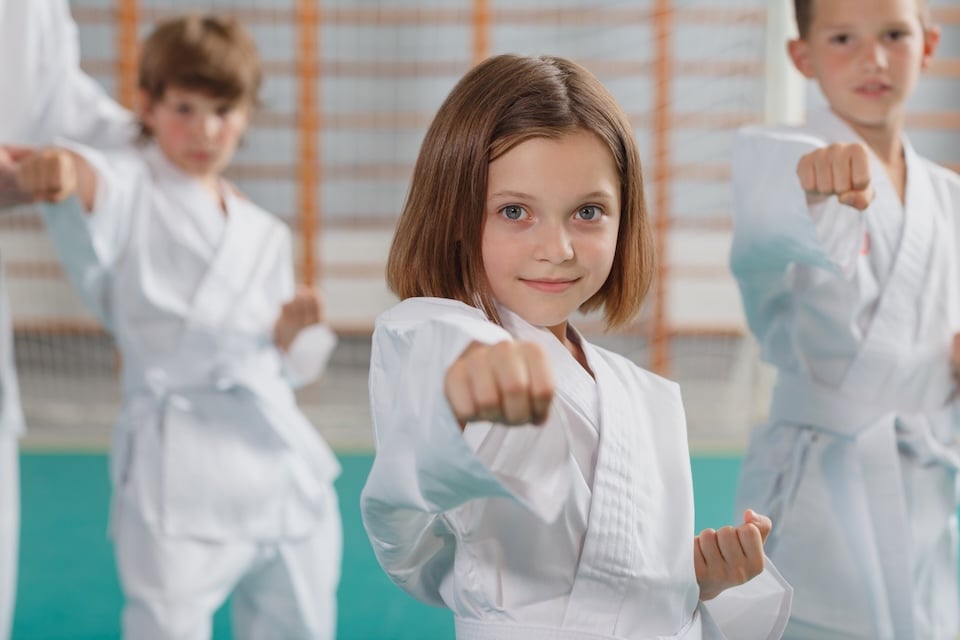
Beyond punches and kicks, karate offers a holistic path of growth. From practical self-defense skills to improved fitness and weight control, it strengthens both body and mind.
Training also instills discipline, focus, and respect, while nurturing confidence and leadership that extend far beyond the dojo. Together, these benefits show why karate remains one of the most rewarding martial arts for all ages.
Self-defense Skills for Real Life
One of karate’s strongest appeals is practical self-defense. From the start, students learn simple but effective techniques like a palm-heel strike or front kick to vulnerable targets such as the nose or groin. As training progresses, defenses against grabs, holds, and pressure-point attacks that build confidence in handling real-world threats become essential.
Karate also sharpens awareness and composure under pressure. Drills and sparring teach quick reactions and calm decision-making, helping practitioners feel safer in daily life. More than just techniques, karate provides the mindset and readiness to protect yourself when it matters most.
Physical Health, Fitness, and Weight Control
Karate offers a complete workout that builds strength, flexibility, and endurance while supporting weight control. A single class can burn 500–900 calories, tone muscles through stances and strikes, and enhance balance, coordination, and cardiovascular health.
Beyond fitness, karate reduces stress and boosts energy, offering variety compared to routine gym workouts. With clear goals like mastering kata, training stays engaging and motivating, leading to lasting physical and mental well-being.
Discipline, Focus, and Character Development
Karate fosters discipline and respect through rituals like bowing, punctuality, and repeated practice. These habits build perseverance and self-control that extend far beyond the dojo.
It also sharpens focus and emotional resilience. Kata and sparring demand concentration, while challenges like belt tests or public demos teach stress management and confidence. With its values of respect, humility, and goal-setting, karate shapes well-rounded individuals ready for personal and professional growth.
Confidence and Leadership for Kids and Adults
Karate is a powerful confidence booster for all ages. Kids beam with pride when breaking a first board or earning a new belt, while adults gain assurance from mastering techniques and overcoming physical limits. These small victories build self-esteem that carries into school, work, and daily life.
As students advance, they often develop leadership skills. Higher ranks may lead warm-ups, mentor beginners, or guide group drills, fostering patience and responsibility. Adults may assist in teaching or organizing, strengthening their ability to lead with encouragement. Performing kata or sparring in front of others also reduces stage fright, preparing students to face challenges with confidence inside and outside the dojo.
Karate in the Olympics and International Recognition
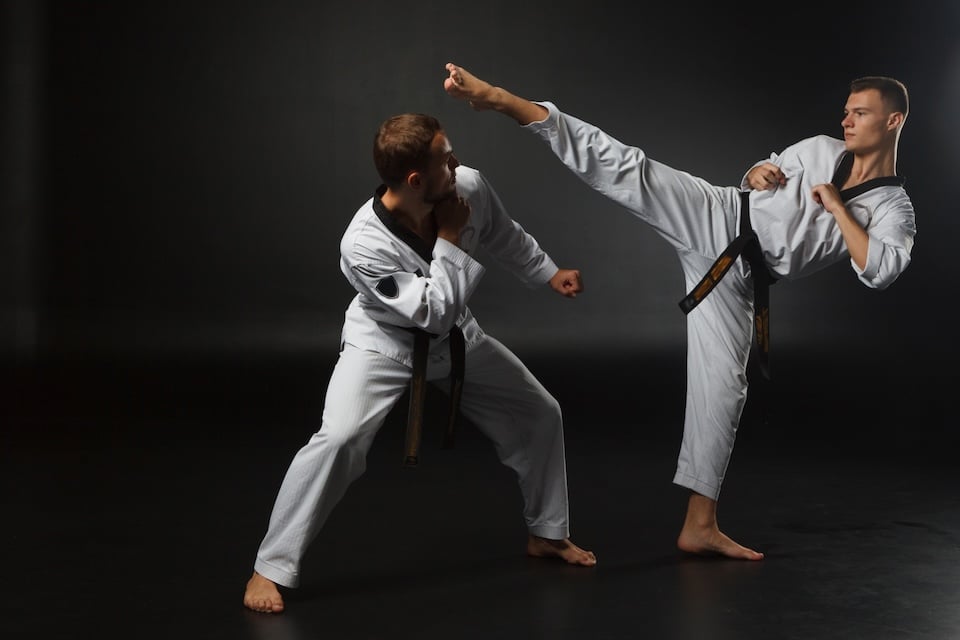
Karate’s Olympic debut in Tokyo 2020 brought the art to millions worldwide, boosting its visibility and sparking new interest. While its place in future Games is uncertain, karate continues to thrive through global competitions and its deep cultural heritage, ensuring a strong role in the martial arts world.
How Karate Became an Olympic Sport
Karate made its long-awaited Olympic debut at Tokyo 2020 (held in 2021), featuring kata and kumite with 8 gold medals awarded. Stars like Ryo Kiyuna (Japan) and Sandra Sánchez (Spain) showcased karate’s precision and power, while athletes from over 20 countries won medals.
Although excluded from Paris 2024 and Los Angeles 2028, the WKF continues to campaign for its return at Brisbane 2032. Even if temporary, Tokyo cemented karate’s status as both a traditional martial art and a global competitive sport.
Impact on Global Popularity and Competition
Karate’s Tokyo 2020 debut reached millions worldwide, boosting enrollments and sparking youth interest. Athletes from over 20 nations won medals, showcasing its global depth.
The Games standardized rules, elevated training, and created role models like Ryo Kiyuna and Sandra Sánchez. Though absent from Paris 2024, karate’s Olympic success cemented it as a global sport and cultural treasure.
Future of Karate in International Martial Arts
Karate’s future looks strong and diverse, even with Olympic status uncertain. The WKF continues to host World Championships and Premier League events, keeping competitive karate vibrant and global.
At the same time, efforts in Okinawa aim to preserve karate as intangible cultural heritage, showing the balance between sport and tradition. Technology, online training, and leagues like Karate Combat are expanding karate’s reach, while female participation and MMA crossover highlight its modern relevance.
With over 100 million practitioners worldwide, karate is set to thrive as both a martial art and cultural treasure, offering competition, self-defense, and lifelong personal growth.
Karate Gear and Equipment
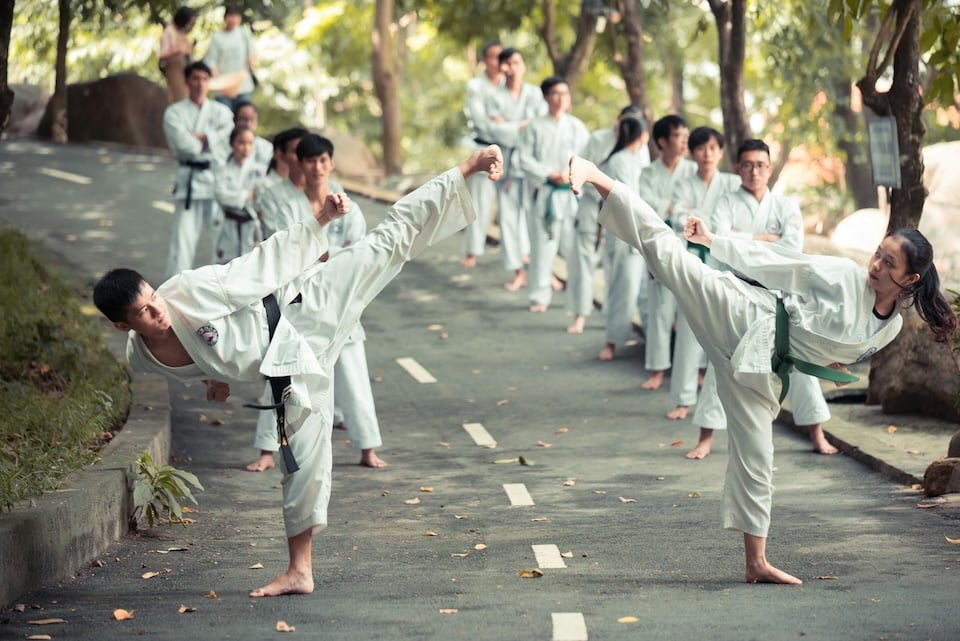
Training in karate isn’t just about techniques – it also involves the right equipment and symbols of progress. From choosing a proper karategi, to understanding the meaning behind belt colors, and using protective gear for safe sparring, these essentials support both skill development and the spirit of the art.
Karategi: Choosing the Right Uniform
The karategi (空手着, karategi) is the traditional white uniform of karate, symbolizing purity and humility. It consists of a jacket (uwagi), pants (zubon), and a belt (obi). Beginners often choose lightweight gis for comfort and affordability, while advanced students prefer heavier fabric (12–14oz cotton, 0.75–0.88lb) for durability and kata performance. Medium weight suits everyday practice.
Brands like Tokaido, Shureido, and Kamikaze are prized for quality, though simple starter uniforms work well too. With proper care – regular washing and air-drying – a gi becomes more than clothing; it reflects equality, discipline, and commitment on the path of karate.
Belts and Ranking Colors Explained
In karate, the belt (obi) is a symbol of progress, not just a way to tie the uniform. Each color marks a stage: white for beginners, yellow and orange for basics, green for growth, blue or purple for advanced skills, brown for maturity, and black for mastery. The black belt is only the beginning of deeper learning, with Dan levels representing decades of dedication.
Belts are treated with respect – often not washed, always tied neatly – and many dojos hold ceremonies for promotions. Over time, a frayed black belt returning to white reminds practitioners of humility. More than ranks, belts act as milestones of discipline, perseverance, and personal growth.
Protective Gear for Kumite Practice
In kumite, protective gear ensures safety while allowing realistic sparring. Standard equipment includes gloves, shin/instep guards, a mouthguard, and a groin protector (mandatory for men in competition). Youth and female divisions also require chest protectors, and children often use headgear. Foot guards, forearm pads, or rib protection may also be added depending on training intensity.
Using gear properly minimizes injuries and builds confidence in practice. Just as important is hygiene—airing out gloves, cleaning pads, and replacing worn items keep training safe and comfortable. Protective gear is truly a karateka’s “armor”, enabling long-term progress in sparring.
Resources to Learn Karate Anywhere
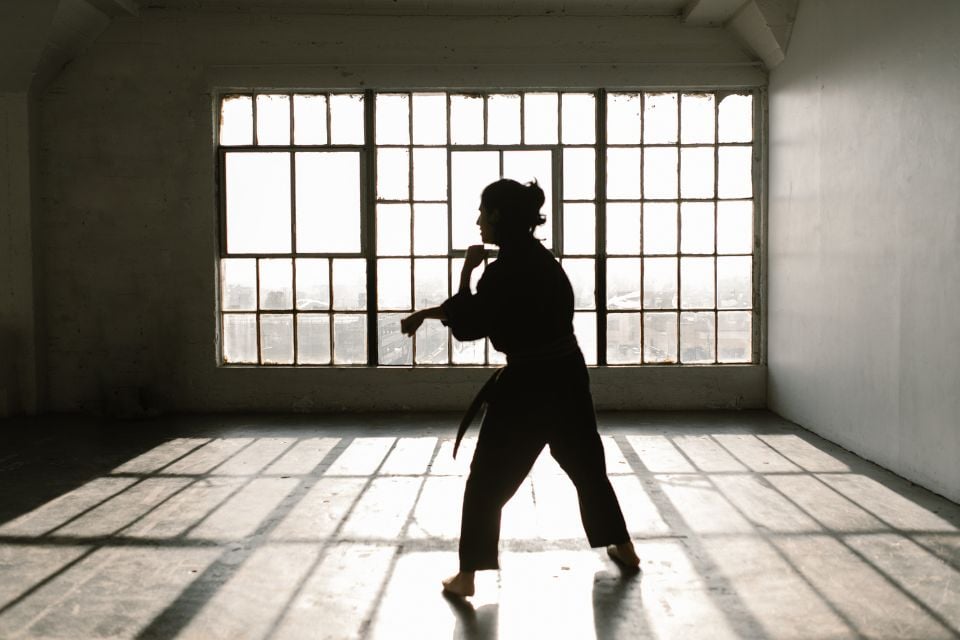
Karate is more than just physical training—it’s a lifelong study of movement, discipline, and culture. Today, practitioners can expand their learning far beyond the dojo through books, online classes, seminars, and international events. These resources make karate accessible to anyone, anywhere, while complementing hands-on practice and preserving its traditions.
Books, PDFs, and Technique Guides
Supplementing dojo training with written resources enriches your understanding of karate. Classics like Karate-Do: My Way of Life and Karate-Do Kyohan by Gichin Funakoshi, or The Bible of Karate: Bubishi, offer philosophy and tradition.
Modern guides such as Masatoshi Nakayama’s Best Karate series and Dynamic Karate detail techniques and kata, while federations provide PDF manuals with belt requirements. Historical works and training journals further support progress, making these resources useful companions but never replacements for real practice.
Online Classes and Video Tutorials
The digital age has made karate learning more accessible than ever. Free video tutorials on YouTube offer kata breakdowns and sparring tips, while structured online courses provide step-by-step instruction (some even offering rank certification, though this is debated).
Many dojos also host live Zoom classes, allowing real-time feedback across borders. Communities like Reddit’s r/karate and dedicated apps with technique libraries or practice trackers further support progress. These tools are excellent supplements, but students must use them wisely to avoid developing bad habits.
Seminars, Camps, and International Events
Immersive experiences like seminars, training camps, and global events give karate practitioners a chance to grow beyond the dojo. Seminars are usually led by high-ranking sensei (先生, sensei) or champions, focusing on areas such as kata bunkai or kumite. Multi-day training camps (gasshuku, 合宿) offer intensive practice in scenic or traditional settings, creating both physical challenge and community spirit.
On the international stage, events like the WKF World Championships, Shotokan World tournaments, and Okinawan cultural exchanges bring karate-ka together worldwide. MOTENAS JAPAN also provides karate-focused travel, combining training with cultural tourism. Specialty camps for kids, women, or even language-and-karate programs further diversify opportunities. These experiences deepen skills, motivation, and camaraderie while celebrating karate’s global community.
Facility Information
| Category | Details |
| Booking (予約, yoyaku) | Online application or direct inquiry via event organizer |
| Duration (所要時間, shoyō jikan) | Seminars: 1–2 days, Camps: 3–7 days, International events: varies |
| Location (場所, basho) | Dojos, cultural centers, conference halls, or outdoor training venues |
| Audience (対象, taishō) | Kids, adults, families, corporate teams, and international participants |
Custom Karate Experiences and Team-Building with MOTENAS JAPAN
MOTENAS JAPAN offers exclusive karate experiences that transform traditional martial arts into a powerful tool for cultural enrichment and team-building. Sessions can be arranged in dojos (道場, dōjō), conference halls, or scenic outdoor venues, providing flexibility in Tokyo, Kyoto, or resort destinations. Each program typically includes a cultural introduction to karate’s history and values, group warm-ups, practice of fundamental techniques, synchronized kata, and safe board-breaking for confidence-building.
Beyond physical training, participants experience karate’s artistry and philosophy through live demonstrations by champion black belts, creating a meaningful connection to the samurai spirit and Bushidō values. Training together nurtures camaraderie, humility, and respect, as all participants bow to the sensei and unite with a spirited “Osu!”. MOTENAS JAPAN manages every detail—from planning and translation to photography and travel coordination—ensuring a seamless experience. The result is an energizing, bonding, and inspiring program that transforms karate into a unique path for both personal and collective growth.
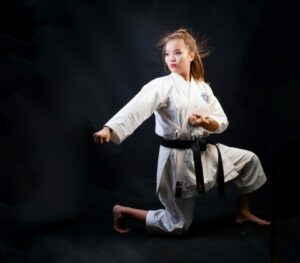
Why Karate Continues to Inspire the World
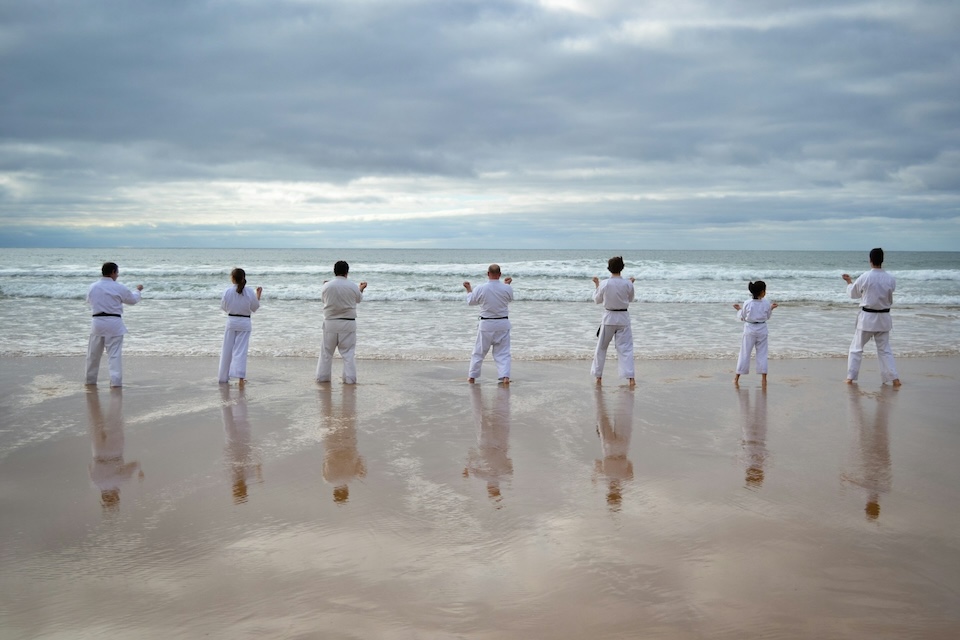
Karate has grown from a hidden Okinawan art into a global practice followed by millions. Its appeal lies in balancing tradition with modern adaptability—preserving centuries-old kata while embracing competition, online learning, and new cultural roles.
Beyond punches and kicks, karate teaches discipline, respect, and self-improvement. It builds confidence in children, resilience in adults, and acts as a cross-cultural bridge uniting people worldwide. Whether for fitness, philosophy, or community, karate continues to inspire because it offers growth for every stage of life.

旅をこよなく愛するWebライター。アジアを中心に16の国にお邪魔しました(今後も更新予定)。
ワーホリを機にニュージーランドに数年滞在。帰国後は日本の魅力にとりつかれ、各地のホテルで勤務。
日本滞在が、より豊かで思い出深いものになるように、旅好きならではの視点で心を込めてお届けします!





